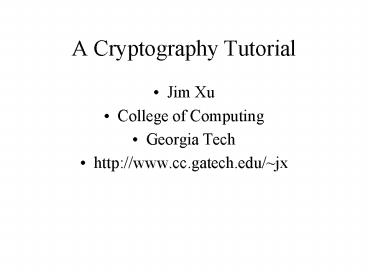A Cryptography Tutorial PowerPoint PPT Presentation
1 / 24
Title: A Cryptography Tutorial
1
A Cryptography Tutorial
- Jim Xu
- College of Computing
- Georgia Tech
- http//www.cc.gatech.edu/jx
2
Why Cryptography?
- Network information needs to be communicated
through insecure channel. - Stored information may be accessed without proper
authorization. - Cryptography is a systematic way to make that
harder.
3
Common Security Requirements
- Secrecy(encryption)
- Authenticity(signature/encryption)
- Integrity (signature/encryption)
- Non-repudiation (signature)
4
What Cryptography can do?
- Encryption only the authorized party can
understand the encrypted message. - Signature allow people to verify the
authenticity of the message.
5
Classical Cryptography
- Shift Cipher (a special case used by Caesar)
- Substitution Cipher
- Affine Cipher
- Vigenere Cipher
- Hill Cipher
- Permutation Cipher
6
Cryptoanalysis
- Ciphertext-only attack
- Known plaintext attack
- Chosen plaintext attack
- Adaptive Chosen plaintext attack
7
Cryptoanalysis
- Shift Cipher English histogram
- Substitution Cipher histogram again
- Affine Cipher histogram
- Vigenere Cipher more complicated stat
- Hill Cipher Known plaintext attack
- Permutation Cipher histogram semantics
8
Frequency of Letter Occurance
9
How to achieve perfect secrecy?
- One-pad have a key as long as the plaintext
- For example, shift cipher is perfectly secure if
the key is random and it is only used to encrypt
one character! - Spurious keys S(n) gt K/(P(nR))-1
- Unicity distance that n to make S(n) zero
10
Modern Cryptography
- Two broad classes
- 1. Shared-key cryptography
- 2. Public-key cryptography
11
Shared-key cryptography
- Rooted in computational complexity
- Sender has M
- Sender sends (M XOR f(x, k), x)
- f is a random function
- Algorithms
- DES, Various fishes, Lucifer, Fiestel, AES
standards (Rijendel), ...
12
DES
- A round can be described as
- Li Ri-1
- The key generation is performed
- An initial permutation PC1 which selects 56 bits
and divide them in two halves - In each round
- Select 24 bits from each half using a permutation
function PC2 - Rotate left each half by one or two position
13
Rich theory on pseudorandomness
- Pseudorandom number/bit generator
- Pseudorandom functions (ideal cryptographic hash
functions) - Stretch a small completely random string into a
longer but less random string - Though less random, indistinguishable to naked
eyes
14
Public Key Cryptography
- Public/private key pair
- Only the owner knows the private key, but
everyone knows the public key - If the message is encrypted with the private key,
then everyone with the public key can recover the
message, but only the owner can generate the
encrypted message
15
Continued
- If the message is encrypted with the public key,
only the owner can decrypted it using its private
key - The first property can be used for signature and
the second property can be used for encryption.
16
Digital signature
- Sender sends M, TE(hash(M), private)
- The receiver compares E(T, public) and compares
it with hash(M) - M is considered genuine if they match
17
RSA
- Find two big prime numbers p and q
- Let B pq
- Choose private key C to be a number that is
coprime with (p-1)(q-1) - Choose public key D such that CD1 mod
(p-1)(q-1)
18
Continued
- Encrypt M TMC (or MD)
- Decrypt M M TD (or TC)
- Theorem (MC)D M mod B
- Why all the numbers that is coprime with B form
a group, and the size of that group is (p-1)(q-1)
19
Security of RSA
- Hinge upon how hard the factorization is
- If one can break down B into p and q
- then finding C CD 1 mod (p-1)(q-1) is easy
- Factorization is found to be quite hard, at least
for now.
20
Cryptographic Protocols
- System needs are more complicated than what the
primitives can provide - Improperly designed, be broken even if none of
the underlying primitives are broken - Hard to check whether it is properly designed
(proof logic/model checking/theorem proving
methods are involved)
21
Key exchange
- Diff-Hellman
- Based on the assumption that knowing prime p and
pn, finding n will be hard - Allow two party to share a key
- A senders B pa and remembers a
- B senders A pb and remembers b
- Both sides can generate p(ab)
- Third party can not do that!
22
Man in the middle
- C can establish a key with both A and B, by
posing as B and A respectively - Solution introduce public key or using return
address as authentication method
23
Public Key Infrastructure
- Need this infrastructure to prevent A from
claiming that B uses the public key that A
generates - Both hierachical and flat infrastructure are
proposed - Revocation list a major headache
24
Advanced Issues
- Group encryption/signature
- Forward security
- Everlasting security

